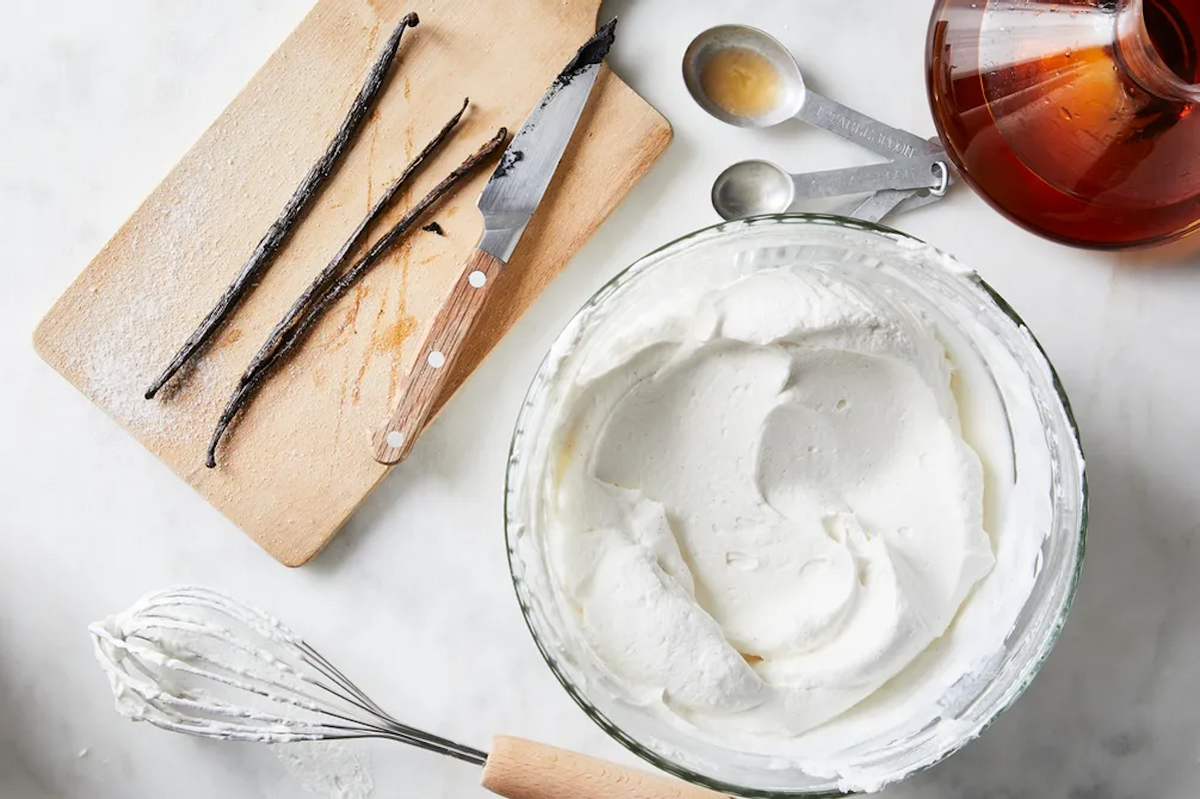6 ways to repurpose leftover vanilla bean pods, according to Dorie Greenspan

Today, Guest Editor Dorie Greenspan is sharing five ways to capture every last drop of flavor from vanilla bean pods.
Vanilla is earthy. It’s ethereal. It’s exotic. It’s indispensable in some recipes and, when added to others on a whim, seems essential. And it’s expensive. At least the good stuff is, and it’s the good stuff that you should be using. Always. If you’re using vanilla extract, make sure it’s pure. A good whiff should either make your head spin or compel you to dab a little behind your ears. And the beans . . . ah, the beans. Vanilla beans are the queens of the vanilla family. The ne plus ultra of flavoring.
A good vanilla bean should be plump and bendable. Dry beans won’t give you the flavor you yearn for (and paid for). The beans should feel moist, maybe even a little sticky, and if they’ve got a kind of silvery sheen, that’s fine.
The most coveted part of the bean is the inner pulp, but the pod packs flavor too and, even after you’ve scraped out the inner seeds or poached both pod and pulp, the pod’s got more to give.
Here are five ways to repurpose leftover vanilla bean pods.
1. Vanilla sugar and salt
The most common use for spent beans is to dry them and bury them in a jar of sugar. Or, better yet, dry the pods and whirr them in a blender or food processor with sugar. The same technique will give you something more unusual: Vanilla salt, a flavoring that you can use in cookies — use it in or on top of chocolate chip, butterscotch, or all-chocolate cookies — caramels, puddings, and more. Tuck the spent pods into a salt cellar or jar filled with kosher salt and let ’em hang out for a few weeks. Of course, the salt is also good on the savory side: try it on roasted carrots, lobster, shrimp, or sweet potatoes. If you want to go all out, whirr the dried pods with some sea salt and then mix that salt with fleur de sel or flake salt. As a rule of thumb, use vanilla sugar or salt in place of the regular version in any recipe. Use it to salt the rim of a margarita glass for an unexpected sweet flavor that will touch your lips. Stir vanilla sugar into your coffee or roll balls of sugar cookie dough in it before baking.
Every few days, give the jar of sugar or salt a shake to ensure that the vanilla flavor is evenly dispersed through the mixture. Oh, and don’t think that you need to use white sugar. Coconut sugar, palm sugar, and even brown sugar will all benefit from the extra oomph.
2. Pierced and poached fruit
Pods — dried, or still fresh — are great for poaching fruit. To get the most flavor out of the pods and into the fruit, run the pods through the fruit — think skewer — and poach away. Vanilla is wonderful with almost every stone fruit as well as with apples, pears, and prunes. Oh, and don’t forget to save the syrup. Depending on what spices you added, it might be nice to sweeten tea, serve over ice cream, or to poach more fruit.
3. Homemade extract
The traditional way to make vanilla extract is to start with fresh beans, slice them lengthwise, and steep them in vodka, counting 3 to 4 beans to about 1 cup of booze. Put the ingredients in a glass jar, shake, then store in a cool, dark place for a couple of months (or longer), shaking whenever you remember. But you can do the same thing with spent beans or pods. You might not have the requisite number of beans at the beginning, but start with what you’ve got and keep adding to the jar, using an extra bean or two (to make up for their spentness). And for a different, somewhat richer flavor, try making the extract with Cognac.
4. Flavored coffee and tea
If you like vanilla coffee, save your pods to stir your joe. Or add a pod to your coffee beans and grind them together. My own preference is to steep the spent pod in tea. The best? Chai tea with vanilla; honey, too.
5. Bath salts
This great idea comes from my assistant, Mary Dodd. She chops old vanilla beans, mixes them with epsom salts, adds a splash of vanilla extract, and has bath salts that are wildly aromatic, calming, and good for all that might ail you.
6. Vanilla oil
This idea comes from our friends at Beyond Good. To make vanilla oil, heat a light, neutral oil such as vegetable, olive oil, or even coconut oil in a saucepan. You don’t want it to sizzle, just have it get warm enough that it will aid the infusion. Place a spent, split vanilla pod into a heat-resistant glass mason jar. Once the oil is warm, pour it slowly and carefully into the jar over the pod — wait until the oil has reached room temperature before putting the lid on. Let it steep for at least a few days and then use it anytime a recipe calls for oil, such as dressings and marinades, or even brownies.

